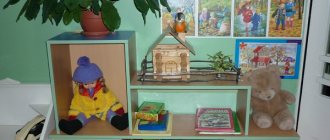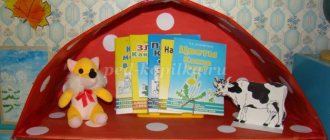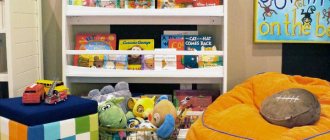What animals should not be kept in a zoo corner?
It is not recommended to keep wild animals in a living area: hedgehogs, marmots, raccoons, dormice, gophers. Most often they are not bred in captivity, but rather caught in the wild, so they are not domesticated and can bite. In addition, some types of rodents carry dangerous diseases: rabies, plague, brucellosis, typhoid, dysentery. Pathogens are excreted in animal excrement and can infect other inhabitants of the zoo and people.
It is prohibited to purchase poisonous plants and reptiles for preschool institutions. For example, there is a risk that nightshade will attract children with its bright berries, which are poisonous. And monstera and philodendron juice will cause burns on the skin.
Even specially bred domestic birds and reptiles carry salmonellosis. To prevent diseases, monthly examination of pets by a veterinarian, timely treatment against parasites and vaccination are required.
Living corner in MBU DO "CD (Yu)TT" Salavat
If you are allergic in the group, you should consult with an allergist, find out which animal has reactions to it, and have as little contact with this species as possible, and take antihistamines before visiting the animal area. Sometimes the allergy goes away over time and the body gets used to it. Often an allergic reaction occurs not to the animals themselves, but to food, bedding, secretions, and dust.
Which animals to choose
“In our living area there are mainly unpretentious pets: Syrian and Djungarian hamsters, rats, gerbil mice, akomis spiny mice, rabbits, guinea pigs, budgies, and fish,” says Maria Skripnik. “But there are also those who need to create special conditions for a full life: Central Asian and red-eared turtles, chinchillas, degus, Achatina snails.”
Who can be accommodated in a zoo corner?
Fish
It is useful to choose fish of different breeds so that children can compare them and find differences. The most unpretentious breeds are considered to be guppies, swordtails, barbs, cardinals, zebrafish, catfish, and goldfish. It is better to place the aquarium in a cool, dark place away from the window.
Some types of fish cannot be kept in the same aquarium. For example, schooling barb fish do not get along well with smaller breeds (they simply eat them or bite off their fins), and also conflict with goldfish. The best neighbors for them will be swordtails, zebrafish, and parrotfish.
In addition, it is necessary to take into account the purity, hardness and acidity of the water. Guppies cannot stand dirt in an aquarium, so they do not get along well with goldfish. You should find out about all this in advance from a consultant at a pet store and read in specialized literature.
Reptiles
An interesting exhibit is a chameleon. By watching him, children learn about the phenomenon of mimicry. Land and waterfowl turtles will take root in the zoo corner.
“But turtles require a large aquarium or cage, an ultraviolet lamp for heating, and special food,” warns Maria Skripnik.
Waterfowl require an aquarium with rocks. Moreover, some of the stones should be located above the water so that the turtles can crawl onto land and bask under the lamp.
Rodents
It is allowed to keep rabbits, guinea pigs, mice, rats, and hamsters in the zoo corner of a preschool institution. Maria Skripnik says that each type has its own characteristics of content:
“For rabbits, rats, and guinea pigs, you have to clean the cage often and feed a lot. But spiny mice do not require frequent changes of bedding, they drink little, are unpretentious in food, but they love to live in the company of their relatives. Hamsters, on the contrary, prefer to live alone. They don't need a large cage, they don't eat much, and they're easy to care for. Some animals (hamsters, chinchillas, rats, Achatina snails) are more active at night and sleep during the day - it’s more interesting to watch them in the evening.”
If rodents live in cages, then they should be placed at a short distance so that the inhabitants of neighboring cages cannot injure each other. If animals are kept in aquariums, there is no such need.
Living corner in MBU DO "CD (Yu)TT" Salavat
Birds
Usually the zoo's corner is home to budgies, canaries, rosellas, cockatiels, and greenfinches. They are easy to care for, have bright colors and are popular with children. In addition, some species breed in captivity, which means kids will be able to watch the emergence and growth of chicks. There are species of parrots that exhibit strong sexual dimorphism—the difference in appearance between males and females. This is also a topic for class.
Plants
Plants can be conveniently divided into climatic zones. For example, imagine the tropical zone with ficus, chamedorea. The desert - aloe and other succulents, the subtropics - azaleas and geraniums.
During classes in the zoo corner, the child is involved in various types of activities: play, work, observation, discussion. This promotes comprehensive, diversified development. A living corner will give preschoolers extensive knowledge about nature and instill a love for the world around them. Getting acquainted with living nature, the child will develop morally, spiritually and aesthetically.
Why do you need a living corner?
According to the study, observing animals increases activity in the prefrontal cortex of the brain. This area is responsible for establishing social contacts and making decisions. And this is not the only benefit that communication with animals will bring to a child.
- Studying nature in practice forms in children a realistic understanding of animals and plants, broadens their horizons, develops logical thinking and the ability to look for interdisciplinary connections.
- According to American journalist Richard Lowe, children who from an early age were introduced to the exploration of nature in all its manifestations, as adults, treat the world around them more responsibly and carefully. A child who takes care of pets reduces the level of aggressiveness and conflict and develops empathy.
- According to research, contact with animals helps a person reduce stress and creates a positive attitude.
According to Maria Skripnik, animal corners develop emotional intelligence in children and teach them to be independent:
“We need to teach children to love, properly care for and be responsible for their pet. This is what living corners are for, she believes. — By working with children and participating in various events, we not only explore environmental issues, but also instill in children a love for animals, teach them to care for a living creature and bear responsibility for it. Often guys want to have a cute little animal, but they know absolutely nothing about it - how to keep it, what to feed it. Then they quickly get tired of it and end up on the street or with other people. This is a lot of stress for the animal. We have pets that are tired of them and are thrown out onto the street and were not kept properly.”
Living corner in MBU DO "CD (Yu)TT" Salavat






